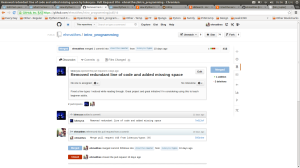Today marks the end of my first 30-day streak of making contributions on GitHub. I had no intentions of starting a streak, but now that I’ve got one going, it’s addictive. More importantly, I find I am learning a great deal, and my overall work habits are improving.
Starting a new project
About a month ago I started teaching an Introduction to Python class, which I teach each fall. This year I decided to use IPython to write up my lesson notes and demonstration programs. In the course of learning IPython, I discovered how easy it is to post notebooks online using IPython Notebook Viewer. I ended up posting the notebooks on GitHub, and sharing them with students through the Notebook Viewer.
I wrote a post about how IPython and GitHub were making my teaching better, and I was quite surprised to see that post sit on the front page of HN for most of a day. The overwhelmingly positive response inspired me to keep working on the project, and before I knew it I had matched my previous streak of 17 days.
30 days: Nothing new on GitHub, but quite meaningful for me
I know there are some really long streaks on GitHub, and I have no intention of setting any records. But I was pleasantly surprised to find that I was learning a lot by maintaining my own streak.
- I made steady progress on my project. I would have made steady progress on this project anyways, but having fun with a streak definitely helped me maintain a steady level of progress. Except for one or two days of simply opening a new issue, the streak has me focusing on writing at least some code each day.
- Simply opening a new issue is not “cheating”. I opened new issues on a couple days when I didn’t have time to make a more serious contribution. But that wasn’t cheating. It gave me the chance to put into writing a number of issues that were stirring in my head. Good documentation always makes a project stronger, and tracking issues effectively is part of forming good documentation habits.
-
I got my first pull request! It was minor, but that’s what I expected for a first pull request. It’s a pretty good feeling to have someone else make even a minor contribution to a project I had started.
- I learned more about git. Three weeks into the project, I decided to host static versions of the notebooks I was creating for students. IPython’s Notebook Viewer is a wonderful tool, but some of the longer notebooks were taking 8-12 seconds to load. GitHub was down one day during class, so students lost access to the public versions of the notebooks. I decided to throw static versions of the notebooks up somewhere, and ended up creating introtopython.org. The load times went down to about one second, and I have a much easier time pointing students to our learning materials. I ended up making a post-commit hook that converts the raw notebooks to html. I had heard of git hooks before, but never had the opportunity to use them until now.
- I kept up with other projects as well. One of my routines each morning is to click the little blue notifications dot at the top left side of the GitHub page. I love the Gittip project, but I just don’t have time to contribute right now. Even though I can’t actively contribute, I still feel connected to that project by skimming the notifications every morning. When I do have some time to contribute, it will be much easier for me to jump into that project.
What’s next? 60 days?
I learned enough from these first 30 days that I want to try for a 60-day streak. I don’t care much for chasing numbers, but I am quite curious to see what the next 30 days will bring. I expect to see a much more refined project, and I hope to have a few more contributors. I expect to learn some more about git, and continue improving my overall workflow. And yes, I do look forward to seeing a larger area of solid green squares on my GitHub page.
There is one thing that might keep me from maintaining my streak, however. I have been a lone hobbyist programmer for most of my life, so I have developed the habit of doing almost all of my work on the master branch. I know I should be working on branches, and I read recently that committing to non-default branches does not count as a contribution; only the merge back into master counts. So it sounds like working on a branch for a couple days, for ten or so commits, will only count as one contribution on the day that branch is merged back into master. I certainly don’t want to let a streak motivate me to have a bad git workflow, so I will happily give up a streak to pick up a better overall workflow.
If these streaks we’ve been hearing about have made you consider starting your own streak, why not begin today? Who knows what you will learn, and what you might accomplish.


